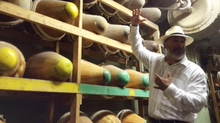How to revive manufacturing in Pittsburgh


We not only can bring back manufacturing jobs from overseas, we can grow them from the ground up, too
Over the past seven years, the United States has experienced its first growth in manufacturing jobs since the mid-1990s, an increase of nearly 1 million positions. Pennsylvania, however, has largely missed out on this recovery. Since 2010, the number of manufacturing jobs in the state has fallen by 8,000, rather than increasing by 46,000, which would have happened if Pennsylvania had kept pace with the nation.
StartFragment
Here in Pittsburgh, some point to the city’s newly diversified economy as a model for revitalizing other “Rust Belt” regions and industries. While it is true that vibrant new fields in technology, health care and bioscience hold tremendous promise for the Pittsburgh area, these new jobs and sectors do not yet extend to all residents, neighborhoods or surrounding mill towns.
As a new study from the Brookings Institution shows, the world-class potential of Pennsylvania’s research universities and innovation economy is not translating into good-paying manufacturing jobs. In Pittsburgh, “deteriorating factories, empty parking lots, dilapidated housing and vacant lots all bear witness to the continuing material and social costs of economic restructuring,” as Georgetown University researcher John Russo recently observed.
A recommitment to manufacturing must be a central component of Pittsburgh and the region’s economic agenda. This means translating the technological leadership and advances that we are currently seeing in the city into Made-in-Pennsylvania advanced-manufacturing jobs. Doing so not only would provide income and jobs for communities of all backgrounds, but it also would create a positive feedback loop between manufacturers and scientists and help spur even greater innovation.
This week, leaders from across the country will converge in Pittsburgh to put these ideas into action. At a summit convened by The Century Foundation and several local partners, including the Keystone Research Center, experts will discuss strategies — and practices already underway — to generate economic prosperity for urban and rural communities throughout the country.
First among these strategies is shifting how we think about manufacturing — looking at the issue, primarily, as affecting workers and communities in our heartland, and not just from the perspective of global companies that want to produce goods in low-wage countries around the world. It is not enough to praise multinational corporations for bringing jobs back to the United States. We also must incentivize employers to stay, invest and expand production at home to begin with.
A second step is focusing on the common needs of many businesses, small and large alike. In nearly every area — from workforce development to process improvement, joint marketing to incubating startups — Pennsylvania underinvests in the “industrial commons,” the educational, scientific and civic infrastructure that helps make manufacturers more competitive. Too often, small businesses can’t invest in these things on their own, in part because they lack the requisite capital, or they choose not to because they fear putting themselves at a competitve disadvantage.
We can begin to change that through closer partnerships between government and private and nonprofit stakeholders. State reshoring teams, for example, would help show suppliers that bringing home manufacturing jobs can save them money in the long run. Pennsylvania could establish such a team using existing entities that have specialized knowledge. The state’s Strategic Early Warning Network, managed by the Steel Valley Authority, could provide customized financial tools that compare the costs of offshored versus reshored production; the state’s Industrial Resource Centers could provide production expertise; and the Governor’s Action Team could provide knowledge of and access to financing.
Similarly, growing manufacturing apprenticeships and industry-training partnerships that “upskill” workers and equip them to use increasingly digitized manufacturing equipment makes it more likely that advanced manufacturing companies will want to locate in Pennsylvania. Leveraging public-pension funds, crowdsourcing, and other innovative funding tools can support capital-starved companies at critical stages of their life cycles. And the public sector should do a better job of tying government assistance to company commitments to lift wages, raise labor standards and locate in places that most need jobs, such as Homestead, Homewood and the Almono site in Hazelwood.
To be sure, many of the strategies needed to revitalize manufacturing, such as fair-trade and international tax policies, must come from Washington, D.C. Sadly, we have yet to see many of the pro-manufacturing, pro-worker policies that Donald Trump promised on the campaign trail made manifest in legislation or executive action.
The good news is that many of the strategies above can be launched right now, with modest strategic investment of resources. In Pennsylvania, we’re beginning to see the political will — and bipartisan consensus — get behind the idea that all residents of the Keystone State must benefit from the state’s emerging economic recovery. This may be one area where multiple levels of government can confound the skeptics, and craft a robust strategy that makes Pittsburgh and the state a poster-child for growing innovative, high-wage manufacturing.
After years of hardship for many Pennsylvanians, it is time to turn the page.
story4102 END Google Standout Tag for Stories pgevoke.components.head_meta END ***************************** EXTERNAL CSS ***************************** pgevoke.exincludes.css_bootstrap-custom / v20170714_1715 pgevoke.exincludes.css_head / v20170508_1641_v2 pg.exincludes.css_common / v20170419_1719 <link rel="stylesheet" href="https://maxcdn.bootstrapcdn.com/font-awesome/4.5.0/css/font-awesome.min.css"> ***************************** JAVASCRIPT ***************************** Console.log() fix for IE8 pgevoke.components.head_end / v20170504_1328 Moving to body end package <l t o : macro name="gigya-head"> <l t o : macro name="pg.includes.getresponsivesize"> <l t o : macro name="pg.exincludes.pgfunctions"> <l t o :macro name="pgevoke.exincludes.js_head"> <l t o : macro name="pg.widgets.common-js"> <l t o : macro name="pgevoke.includes.widgets-common-js"> <l t o :macro name="pgevoke.includes.js_comments"> Twitter embed code <l t o : macro name="pg.ads.init_new"> Moving to packages <l t o : macro name="pg.exincludes.adinit"> <l t o : macro name="pg.exincludes.adbidders">
StartFragmentStephen Herzenberg is an economist with the Keystone Research Center, which will release the paper, “An Agenda for Growing High-Wage Pennsylvania Manufacturing” this week. Andrew Stettner is a Senior Fellow with the Century Foundation’s Bernard L. Schwartz Rediscovering Government Initiative.EndFragment
Original article published: http://www.post-gazette.com/opinion/Op-Ed/2017/10/15/How-to-revive-manufacturing-in-Pittsburgh/stories/201710150034
EndFragment




















